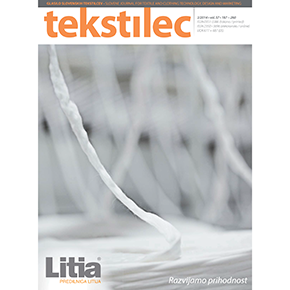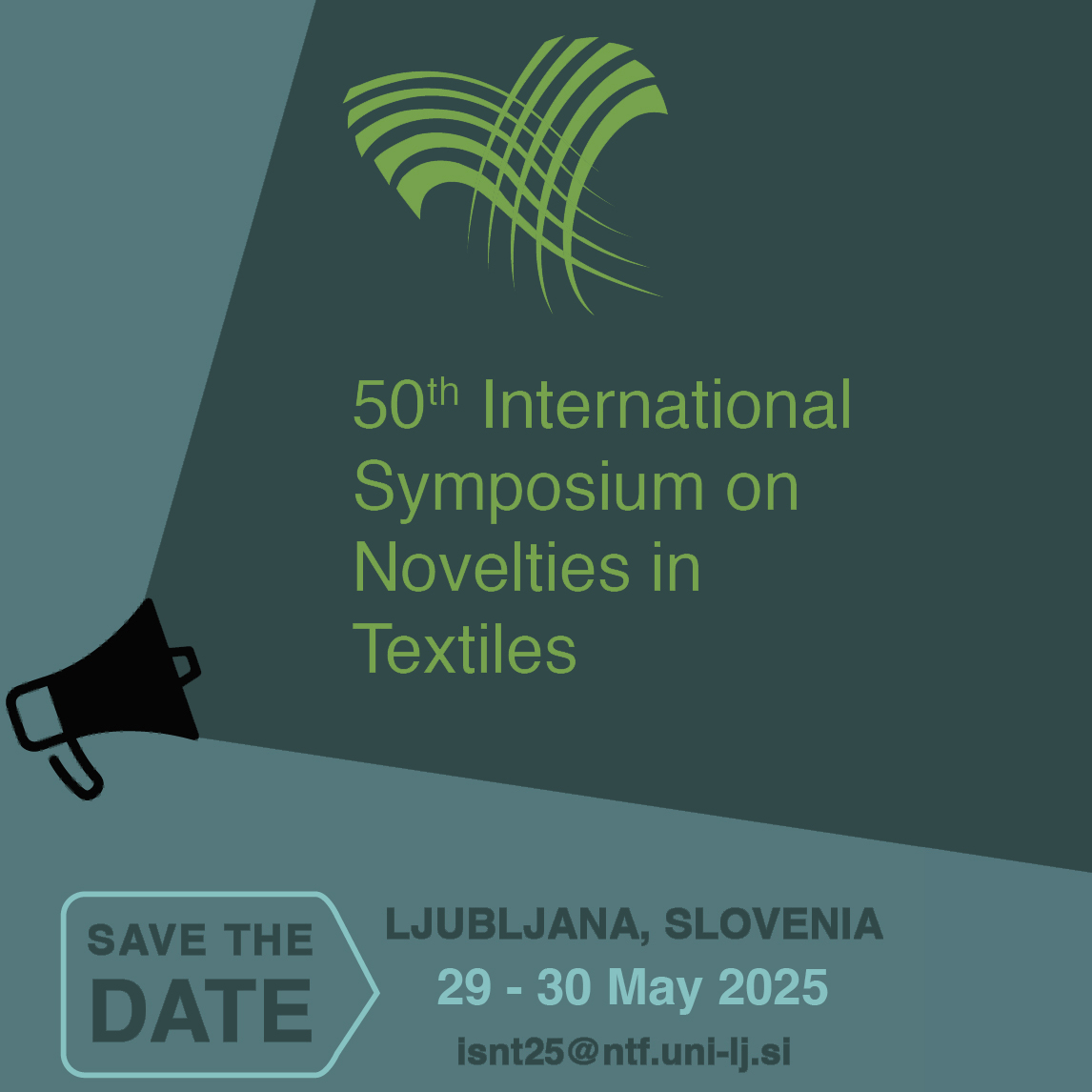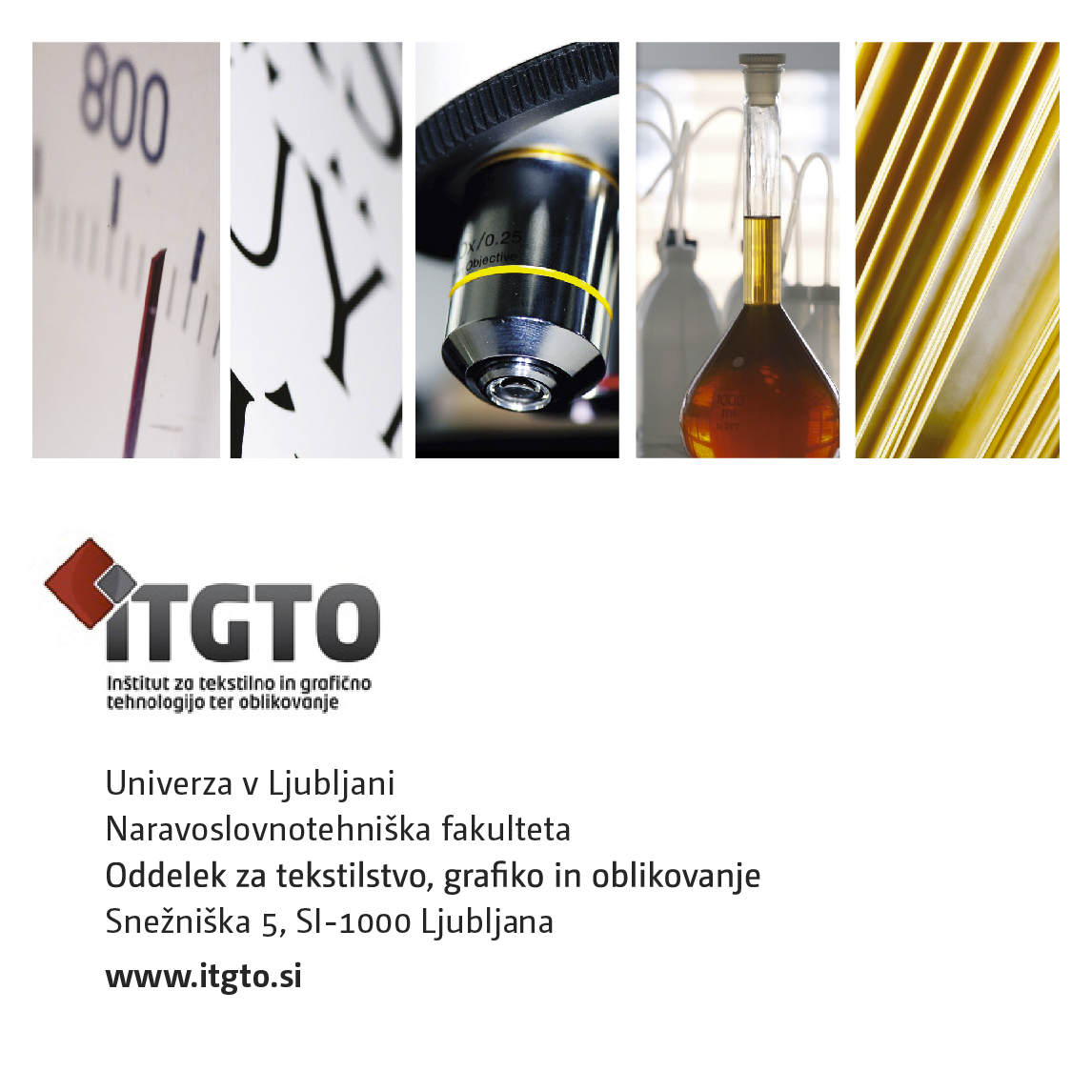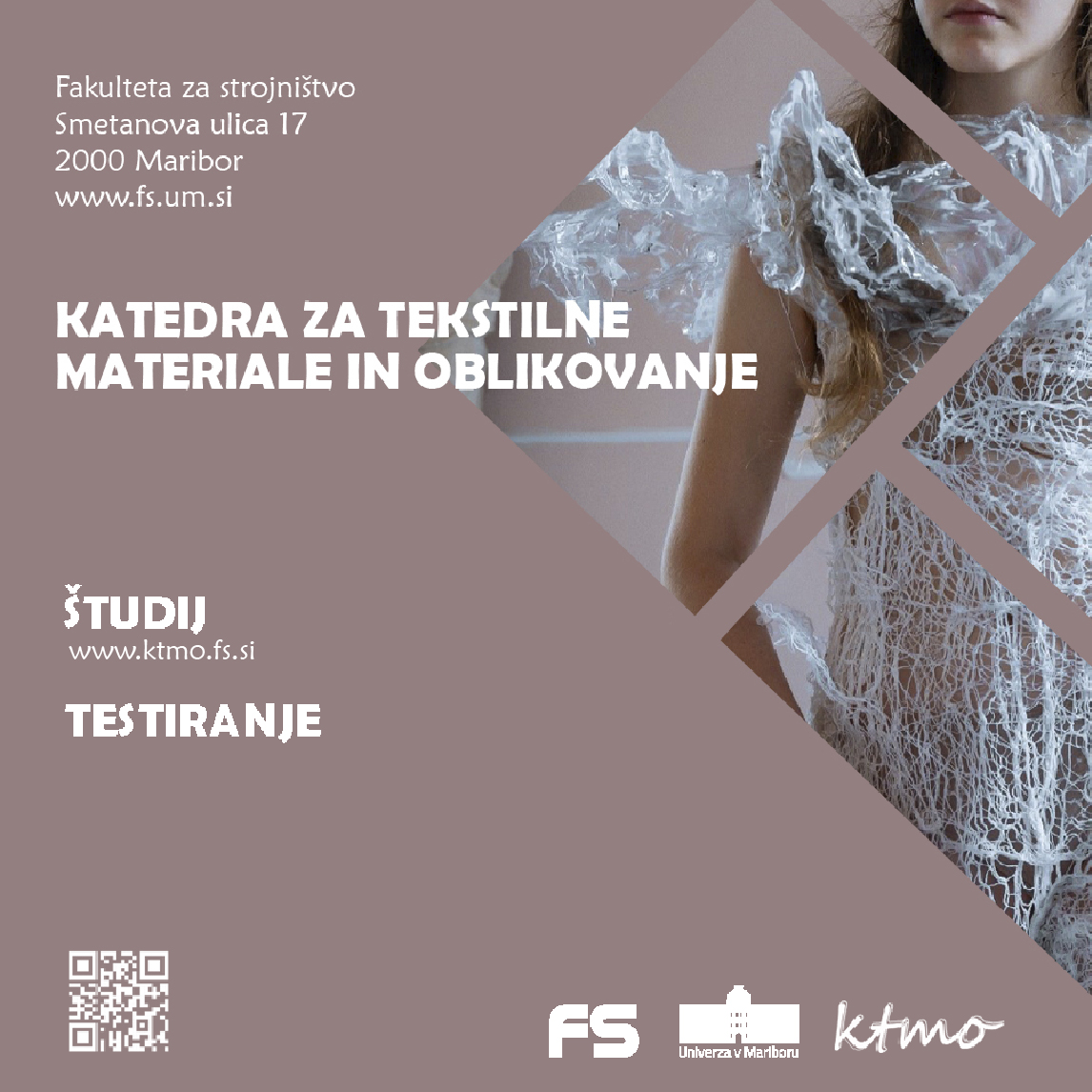CONTENTS
SCIENTIFIC ARTICLES
190 Texture – Raster – Pattern – Picture • Špela Udovič Abstract and References
University of Ljubljana, Faculty of Natural Sciences and Engineering, Department of Textiles, Snežniška 5, 1000 Ljubljana, Slovenia
Scientific Review
Received 05-2014 • Accepted 07-2014
Corresponding author:
M.Sc. Špela Udovič
E-mail: spela.udovic1@gmail.com
Abstract
This article deals with the issue of viewers’ perception, observation and understanding of certain works of art that can reasonably be linked to the creation of textiles. In this study, we wanted to justify the assumption that the visual structure of a pattern may be comparable to the grammar of some paintings and graphic works. Our viewpoints are based on the postulate that a work of art can be transformed and consequently perceived as a pattern through repeated variations and that the visual expressiveness of a pattern can also achieve the status of a work of art. With the analysis of image areas, we tried to prove that the structure of the visual field is one of the essential factors that affect both the perception of paintings and art matter patterns. The image surface is the fundamental part of the area perceived in the visual system. Every image surface in space can be observed in a visual and artistic way. When an image surface is a part of a work of art, e.g. a pattern or picture, we experience and analyse it from the perspective of art viewing. In artistic terms, the image surface can be perceived as an art surface of paintings, drawings, patterns etc. The aspects of its creation are reflected in the properties of textures, structures, factures, patinas and raster. The features of colour relationships and colour modulation which can be seen in the form of textures and raster are implied by fine art in different models. The halftoning and texturing can connect the patterns of Lia Cook and Ghada Amer textile images, as well as of Victor Vasarely and Bridget Riley paintings. In Riley’s paintings, the textural grammar is highlighted in the shape structures forming the visual field, whereas Ghada Amer also expresses herself through the hapticity of textile materials which are mainly used in the conceptual sense.
Keywords: visual field, surface, texture, raster, pattern, picture
References
- BUTINA, Milan. Prvine likovne prakse. Ljubljana: Debora, 1997.
- KUMAR, Marko. Tehnologija grafičnih procesov: 3., prenovljena in razširjena izdaja. Ljubljana: Center RS za poklicno izobraževanje, 2008.
- BRADDOCK, Sarah E. in O’MAHONY, Marie. Techno textiles : revolutionary fabrics for fashion and design. London: Thames and Hudson. 1999.
- ŠUŠTERŠIČ, Nina, BUTINA, Milan, De GLERIA, Blaž, SKUBIN, Iris in ZORNIK, Klavdij. Likovna teorija : učbenik za likovno teorijo v vzgojnoizobraževalnem programu umetniška gimnazija – likovna smer. Ljubljana: Debora, 2004.
- KOČEVAR, Tanja Nuša. Vpliv parametrov konstrukcije in kompozicije tkanin na optično mešanje barv na njeni površini : doktorska disertacija. Ljubljana: Univerza v Ljubljani, Naravoslovnotehniška fakulteta, Oddelek za tekstilstvo, 2000.
- 1000 Patterens. Uredila Drusilla Cole,. London: A & C Black, 2003.
- SEURAT, Georges Pierre. La Parade. 1887−89 [dostopno na daljavo],[citirano 3.11.2008]. Dostopno na svetovnem spletu: <http://en.wikipedia.org/wiki/File:Seurat-La_Parade_detail.jpg>.
- COOK, Lia, SORKIN, Jenni in TROMBLE, Meredith. Lia Cook. Winchester: Telos Art Publishing, 2002.
- COOK, Lia. Four by Four. 2007 [dostopno na daljavo],[citirano 3.11.2008]. Dostopno na svetovnem spletu: <https://picasaweb.google.com/johanssonprojects/Thread#5079903373629558594>.
- COOK, Lia. An investigation: woven faces and neuroscience. Textile Forum, 2011, št. 18(4), 42−43.
- COOK, Lia. Facing Maze. 2010 [dostopno na daljavo],[citirano 3.11.2008]. Dostopno na svetovnem spletu: <https://www.cca.edu/academics/faculty/lcook>.
- LEKSIKON slikarstva: A-Ž. Uredil Drago Bajt. Ljubljana: Tehniška založba Slovenije, 1996.
- SEMENZATO, Camillo. Svet umetnosti. Ljubljana: Mladinska knjiga, 1979.
- UDOVIČ, Špela. Vzorec kot slikovno polje ali likovna kompozicija kot vzorec: oblikovanje ovojnega papirja pri pouku grafičnega oblikovanja. Likovna vzgoja, 2011, 11(53/54), 28−33.
- VASARELY, Victor, Metagalaxie. 1979 [dostopno na daljavo],[citirano 3.11.2008]. Dostopno na svetovnem spletu: <http://www.ebay.de/itm/VICTOR-VASARELY-GROSSE-ORIGINAL-GRAFIK-SERIGRAPHIE-METAGALAXIE-VP-1708-/300928468796>.
- VASARELY, Victor. Alom, 1966 [dostopno na daljavo],[citirano 3.11.2008]. Dostopno na svetovnem spletu: <http://www.radford.edu/rbarris/Women%20and%20art/post%20abstract%20expressionism%20pt%201.html>.
- TRSTENJAK, Anton. Psihologija barv. Ljubljana: Inštitut Antona Trstenjaka, 1996.
- DINTINJANA, Mia. Bridget Riley. Likovne besede : revija za likovno umetnost, 2001, št. 55/56, 50−75.
- MEDVED Andrej, FER Briony, NANCY, Jean-Luc, GABERŠČIK Boris, PINTER Tihomir, JERAŠA Jaka in LESKOŠEK Ivan. Abstraktno slikarstvo od Mušiča do Rimeleja: abstraktno kot sublimno. Piran: Obalne galerije (Ljubljana: Povše), 2004.
- RILEY, Bridget,. Arrest 2. 1965 [dostopno na daljavo],[citirano 3.11.2008]. Dostopno na svetovnem spletu: <http://www.op-art.co.uk/op-art-gallery/bridget-riley/bridget-riley-arrest-2-1965>.
- Contemporary textiles : the fabric of fine art. Uredila Nadine Käthe Monem. London: Black Dog Publishing, cop., 2008.
- REILLY, Maura. Ghada Amer. New York: Gregory R. Miller & Co., 2010.
- AMER, Ghada. Red Strokes on Raw Canvas. 2004 [dostopno na daljavo],[citirano 3.11.2008]. Dostopno na svetovnem spletu: <http://www.elitismstyle.com/blogazine/wp-content/uploads/2011/01/ghada-amer-red-strokes1.jpg>.
- NAKAMURA, Shigeki. Pattern sourcebook : around the world : 250 patterns for projects and designs. Beverly: Rockport Publishers, 2008.
- UDOVIČ, Špela, KOVAČEV, Asja Nina, RODICA, Barbara. Raziskava semantičnih razsežnosti oblik in barv v vzorcu »Wild Rose«. Tekstilec, 2013, 56(3), 207−221.
202 Use of Chromatic Adaptation Transforms for Prediction of Colours on Display • Original Scientific Paper
• Tanja Ropas in Dejana Javoršek Abstract and References
University of Ljubljana, Faculty of Natural Sciences and Engineering, Department of Textiles, Snežniška 5, 1000 Ljubljana, Slovenia
Original Scientific Article
Received 04-2014 • Accepted 07-2014
Corresponding author:
Assis. Prof. D.Sc. Dejana Javoršek
Tel.: 00386 1 200 32 65
E-mail: dejana.javorsek@ntf.uni-lj.si
Abstract
Colour management is the basic method which guarantees the optimal appearance of colour on computer displays in digital prepress. The aim of this research was to determine whether it is possible to predict the appearance of colour on a wide gamut display using chromatic adaptation transforms when changing the display white point from 6500 K to the following values of the colour temperature of the display white point: 5000 K, 5500 K, 7000 K, 7500 K and 9300 K. For a colour adaptation, three chromatic adaptation transforms were used, i.e. bradford, von Kries and XYZ Scaling model. The measurements obtained at 6500 K white point were used as reference to calculate the adapted colour values for the remaining five white points. Finally, the colour differences between the measured and adapted colour values for each white point were calculated to evaluate the performance of each chromatic adaptation transform. The results of calculated colour differences showed small colour differences (values below 3) for a large number of colour patches for all white point pairs; in consequence, it was confirmed that it is possible to satisfactory predict the appearance of colour on a display using chromatic adaptation transforms. The best results were obtained with the XYZ Scaling model, the von Kries model also gave good results, whereas the bradford model gave contrary to expectations the worst results. It was also confirmed that the values of colour differences increase relative to the rise of colour differences between the source and destination white point, as the biggest colour difference was observed between 6500 K and 9300 K white points and the smallest between 6500 K and 7000 K. The research also showed that different chromatic adaptation transforms adapt the colour values of different colours well in respect to their lightness, chroma and hue.
Keywords: display, chromatic adaptation, XYZ Scaling model, bradford model, von Kries model
References
- FAIRCHILD, Mark D. Color appearance models. Second edition. Chichester: John Wiley & Sons, 2006. 385 str.
- SIST ISO 12646:2010/Dod 1:2014 Grafična tehnologija – Zasloni za barvno preskušanje – Značilnosti in pogoji za vizualno opazovanje – Dodatek 1. 18 str.
- Chromatic adaptation. V Wikipedija: the free encyclopedia [dostopno na daljavo]. Obnovjeno 21. maj 2013 [citirano 23. 6. 2013]. Dostopno na svetovnem spletu: <https://en.wikipedia.org/wiki/Chromatic_adaptation>.
- Digital color imaging handbook. Uredil Gaurav Sharma. Boca Raton [etc.]: CRC Press, 2003, 56−57.
- FINLAYSON, Graham D. in SÜSSTRUNK, Sabine. Spectral sharpening and the Bradford transform [dostopno na daljavo]. Obnovljeno 7. julij 2011 [citirano 15. 7. 2013]. Dostopno na svetovnem spletu: <http://infoscience.epfl.ch/record/34077/files/FinlaysonS00.pdf>.
- SÜSSTRUNK, Sabine, HOLMB, Jack in FINLAYSON, Graham D. Chromatic adaptation performance of different RGB sensors [dostopno na daljavo]. Obnovljeno 9. julij 2011 [citirano 20. 6 2013]. Dostopno na svetovnem spletu: <http://infoscience.epfl.ch/record/34049/files/SusstrunkFH01.pdf>.
- ĐORĐEVIĆ, Dejana, JAVORŠEK, Andrej in HLADNIK, Aleš. Primerjava CMCCAT2000 in bradfordskega modela kromatične prilagoditve. Tekstilec, 2009, 52(4−6), 91−101.
- ĐORĐEVIĆ, Dejana, JAVORŠEK, Andrej in HLADNIK, Aleš. Performance of five chromatic adaptation transforms using large number of color patches. Acta graphica, 2009, 20(1/4), 9−19.
- ĐORĐEVIĆ, Dejana, JAVORŠEK, Andrej in HLADNIK, Aleš. Comparison of chromatic adaptation transforms used in textile printing sample preparation. Coloration Technology, 2010, 126(5), 275−281, http://dx.doi.org/10.1111/j.1478-4408.2010.00258.x.
- WESTLAND, Stephen in RIPAMONTI, Caterina. Computational color science: using matlab. Chichester: John Wiley & Sons, 2004. 207 str.
- LINDBLOOM, Bruce. Bruce Lindbloom.com [dostopno na daljavo]. Obnovljeno 24. marec 2008 [citirano 12. 7. 2013]. Dostopno na svetovnem spletu: <http://www.brucelindbloom.com/>.
- KATOH, Naoya in NAKABAYASHI, Kiyotaka Applying mixed adaptation to various chromatic adaptation transformation (CAT) models [dostopno na daljavo]. Obnovljeno 18. oktober 2011 [citirano 7. 7. 2013]. Dostopno na svetovnem spletu: <http://pdf.aminer.org/000/540/731/applying_mixed_adaptation_to_various_chromatic_adaptation
_transformation_cat_models.pdf>. - CIE 15:2004. 3rd edition. Technical report. Colorimetry. Washington, D.C.: International Commission on Illumination, 2004, 71 str.
- HUNT, Robert W. in POINTER, Michael R. Measuring Colour: Fourth Edition. Chichester : John Wiley & Sons, 2011. 469 str.
- User requirements for a flat panel display (FPD) as master monitor in an HDTV programme production environment (2008). [dostopno na daljavo]. BT Series, Broadcasting service (television). Report ITU-R BT.2129 (05/2009) [citirano 2. 8. 2013]. Dostopno na svetovnem spletu: <http://www.itu.int/dms_pub/itu-r/opb/rep/R-REP-BT.2129-2008-PDF-E.pdf>.
- Altering color dramatically with a single setting : examining color temperature on an LCD monitor. EIZO Corporation [dostopno na daljavo]. Obnovljeno 30. marec 2009 [citirano 22. 7. 2013]. Dostopno na svetovnem spletu: <http://www.eizo.com/global/library/basics/color_temperature_on_an_LCD_monitor/>.
- PASCALE, Dänny. A Review of RGB color spaces …from xyY to R’G’B’. Montreal: The BabelColor [dostopno na daljavo]. Obnovljeno 10. januar 2011 [citirano 26. 6. 2013]. Dostopno na svetovnem spletu: <http://www.babelcolor.com/download/A%20review%20of%20RGB%20color%20spaces.pdf>.
- SIST ISO 3664:2011 Grafična tehnologija in fotografija – Pogoji za vizualno opazovanje. 33 str.
- BRAČKO, Sabina in ĐORĐEVIĆ, Dejana. Merjenje barv : vaje. Ljubljana: Naravoslovnotehniška fakulteta, Oddelek za tekstilstvo, 43 str.
212 Comparison Between Measured and Proposed Back Length Distances for Pattern Block Construction
• Tanja Podbevšek Abstract and References
University of Ljubljana, Faculty of Natural Sciences and Engineering, Department of Textiles, Snežniška 5, 1000 Ljubljana, Slovenia
Original Scientific Article
Received 04-2014 • Accepted 07-2014
Corresponding author:
D.Sc. Tanja Podbevšek
E-mail: tanja.podbevsek@ntf.uni-lj.si
Abstract
The aim of this study was to compare the back length distances (BacLen) from contemporary construction systems with the measured back length distances of the Slovenian young female population to establish which back length presented in different contemporary construction systems fits best to the body dimension of a specific target market group. 160 female students (aged between 19 and 27 years) from the University of Ljubljana (Slovenia) volunteered for the study. The results showed that the measured back length distances differed significantly from those obtained from the tables of contemporary construction systems or calculated as a secondary measure according to these systems. The measured BacLen distances were the same in all size groups and did not increase as did with all analyzed contemporary construction systems. The range of measured BacLen distances inside each size group was substantial (33−43 cm) and the measured BacLen distances were not in correlation with the body height, bust girth and in consequence nor with the calculated BacLen distances. In conclusion, the values for back length distances as proposed by different contemporary construction systems differ significantly from the measured ones in the young Slovenian female population. We thus suggest including back length distance as a directly measured parameter for a pattern block construction when producing made-to-measure clothes.
Keywords: pattern construction, anthropometric measurements, back length, dress, basic pattern block
References
- ALEXANDER, Marina, CONNELL, Lenda Jo and PRESLEY Ann Beth. Clothing fit preferences of young female adult customers. International Journal of Clothing and Technology, 2005, 17 (1), 52−64, http://dx.doi.org/10.1108/09556220510577961.
- PODBEVŠEK, Tanja. Market segmentation in the light of clothing anthropometry. In: 5th World Textile Conference AUTEX 2005, 27-29 June 2005, Portorož, Slovenia. Ed. Alenka MAJCEN LE MARECHAL et al. Proceedings. Maribor: Faculty of Mechanical Engineering, Department of Textiles, 2005, str. 671-676.
- ASHDOWN, Susan P. and DUNNE, Lucy. A study of automated custom fit: readiness of the technology for the apparel industry. Clothing & Textile Research Journal, 2006, 24(24), 121−136.
- STIEGLER, Margarete and MÜLLER-WILDE, Ursula. Schnittkonstruktionen für Röcke und Hosen – System M.Müller & Sohn. München: Rundschau-Verlag, 1996.
- STIEGLER, Margarete and MÜLLER-WILDE, Ursula. Schnittkonstruktionen für Kleider und Blusen. München: Rundschau-Verlag, 1997.
- KROLOPP, Luise and STIEGLER, Margarete. Schnittkonstruktionen für Jacken und Mäntel : System M. Müller & Sohn. München: Rundschau-Verlag, 1994.
- ABRAM ZVER, Marta. Ženska obleka – osnove konstruiranja. Velenje: ModART, 2003.
- JULEAN, R., HALÁSZ, M. Comparison of decimal and Müller-type base pattern design for women’s clothes. In Proceedings of 2nd IN-TECH-ED ’02. April 2001. Budapest, Hungary, 202−206.
- ALDRICH, Winifred. Metric Pattern Cutting. 4th edition. Oxford Malden, Carlton: Blackwell Publishing, 2004.
- MORS DE CASTRO, Lucia. Patternmaking in Fashion – Step by Step. Köln: Evergreen, 2010.
- JANSEN, Jutta. Systemschnitt 1, Modeschnitte für Röcke, Blusen, Hemden, Kleider, Jacken, Hozen. Berlin: Schiele & Schön, 1994.
- ISO 8559:1989 Garment construction and anthropometric surveys – Body dimensions.
- BURGO, Fernando. Il modellismo. Tecnica del modello sartoriale e industrial. 3th edition. Milan: Instituto di Moda Burgo, 1998.
- ARMSTRONG, Helen Joseph. Patternmaking for fashion design. 4th edition. Upper Saddle River, N.J.: Pearson Prentice Hall, 2006.
- SIST EN 13402-3:2005 Označevanje velikosti oblačil – 3. del: Mere in koraki., 29 pp.
- ISO 3635:1981 Size designation of clothes – Definitions and body measurement procedure.
- STJEPANOVIĆ, Zoran, RUDOLF, Andreja, JEVŠNIK, Simona, CUPAR, Andrej, POGAČAR, Vojko and GERŠAK, Jelka. 3D virtual prototyping of a ski jumpsuit based on a reconstructed body scan model. Buletinul Institutului Politehnic din Iaşi. Secţia Textile, Pielärie, 2011, tom. 57 (61), fasc. 1, 17−30. <http://www.tex.tuiasi.ro/BIP/1_2011/17-30_2_Stejpanovic_.pdf>.
- JEVŠNIK, Simona, PILAR, Tanja, STJEPANOVIĆ, Zoran and RUDOLF, Andreja. Virtual prototyping of garments and their fit to the body. In DAAAM International scientific book 2012. Ed. Branko Katalinić. Vienna: DAAAM International, 2012, 601−618.
220 In Impact of Fibre Composition and Sports T-Shirt Ventilation on Thermal Comfort • Dragana Grujić1,
Svjetlana Janjić1, Damjana Celcar2, Danijela Jokanović1 and Simona Jevšnik3 Abstract and References
1University of Banja Luka, Faculty of Technology, V. Stepe Stepanovića 73, Banja Luka, Republic Srpska, Bosnia and Herzegovina
2University of Primorska, Faculty of design, Prevale 10, 1236 Trzin, Slovenia
3Istanbul Technical University, Faculty of Textile Technologies and Design, İnönü Caddesi, Carigrad, Turkey
Original Scientific Article
Received 05-2014 • Accepted 07-2014
Corresponding author:
Assis. Prof. D.Sc. Dragana Grujić
E-mail: dragana.grujic@unibl.rs
Abstract
People with increased secretion of sweat constantly deal with the problem of sweating already at low physical strain in various environmental conditions and seek solutions to achieve the desired thermal comfort of garments. Appropriate thermal comfort when wearing clothes can be achieved only with a suitable choice of textiles, an appropriate clothing design and the construction of clothing cutting patterns constituting the garment. This research hence focuses on the influence of fibre composition of knitted clothes and the design of men’s sports T-shirts on the thermal physiological comfort of clothes during the process of wearing in terms of thermal and sorption properties. Important parameters to determine thermal comfort are the amount of secreted sweat and the amount of sweat absorbed by clothes. The amount of secreted sweat is influenced by climatic conditions, physical activity of a person and their tendency to perspiration, whereas the amount of sweat absorbed by clothes is influenced by the thermal and sorption properties of knitted clothes, as well as by the openness of clothing. The latter enables ventilation, resulting in a more efficient heat exchange between the body and environment. For the purpose of this research, we tested the following knitted clothes parameters: thermal conductivity (l), air permeability (Q), water vapour permeability (WVP) and the ability to retain water (WRV). The influence of cuts of men’s T-shirts made from knitted fabrics of various fibre composition on the ventilation and comfort was tested on the basis of the amount of secreted sweat (Esw) during the process of wearing as a physiological parameter of a person and the amount of sweat accumulated in the T-shirt (Wsw) as the parameter of knitted clothes sorption properties. The results showed that the fibre composition of knitted clothes and the design of a sports T-shirt substantially influence the amount of sweat accumulated in the T-shirt and in consequence, the comfort during the process of wearing.
Keywords: sportswear, clothing ventilation, thermal comfort, sweat accumulation
References
- GRUJIĆ, Dragana: Vpliv snovnih lastnosti tkanin na toplotno fiziološko udobje oblačil : doktorska disertacija. Maribor, 2010.
- BISHOP, A. Phillip., BALILONIS, Gytis, DAVIS, Jon Kyle, ZHANG Yang. Ergonomics and Comfort in Protective and Sport Clothing: A Brief Review. Journal of Ergonomics, 2013, doi:10.4172/2165-7556.S2-005.
- ROSSI, R., Interactions between protection and thermal comfort. V Textiles for protection. Edited by Richard A. Scott. Woodhead Publishing in Textiles, The Textile Institute, 2005, 233-260.
- GRUJIĆ, Dragana, GERŠAK, Jelka. Amount secreted depedence and of absorbed sweat in clothing from material properties and climatic conditions. V Fifth International Scientific Conference Contemporary Materials 2012, Academy of Sciences and Arts of the Republic of Srpska, Banja Luka, 2012, 625−636.
- YOO, Hwa Sook, HU, Y. S., KIM, E. A. Effect of heat and moisture transport in fabrics and garments determined with a vertical plate sweating skin model. Textile Research Journal, 2000, 70(6), 542−549, doi: 10.1177/004051750007000612.
- KIM, J.O., Dynamic moisture vapour transfer through textiles. Textile Research Journal, 1999, 69(3), 193−202, doi: 10.1177/004051759906900306.
- GRUJIĆ, Dragana, GERŠAK, Jelka, RISTIĆ, Mihajlo. Uticaj fizikalnih i sorpcijskih svojstava tkanina na količinu upijenog znoja u odjeći, Tekstil, 2010, 59(3), 68−79.
- CELCAR, Damjana, GERŠAK, Jelka in MENANDER, Harriet. Vrednotenje toplotnih lastnosti tekstilij in njihovih kombinacij, Tekstilec, 2010, 53(1−3), str.12.
- CROCKFORD, G. W., CROWDER, M., PRESTIDGE, S. P. A trace gas technique for measuring clothing micro climate air exchange rates, British Journal of industrial Medicine, 1972, 29, 378−386.
- CROCKFORD, G. W., ROSENBLUM, H. A. The measurment of clothing micro climate volumes. Clothing Research Journal, 1974, 2(3), 109−114.
- REISCHL, U., SPSUL, W. A., DUKES-DOBOS, F. N., HALL, E. G. Ventilation Analysis of Industrial Protective Clothing. V Trends in Ergonomics/Human Factors IV. Holland, 1987.
- LOTENS, W. A., HAVENITH, George. Ventilation of Rainwear Determined by a Trace Gas Method. V Environmental Ergonomics. New York : Taylor & Francis, 1988, 162-172.
- HAVENTIH, George, HEUS, Ronald, LOTENS, Wouter A. Clothing ventilation, vapour resistance and the permeability index: changes due to posture, movement and wind. Ergonomics, 1990, 33(8), 989-1005, doi: 10.1080/00140139008925308.
- KE, Ying, HAVENITH, George, ZHANG, Xianghui, LI, Xiaohui, LI, Jun. Effects of wind and clothing apertures on local clothing ventilation rates and thermal insulation. Textile Research Journal, Published online before print December 12, 2013, doi:10.1177/0040517513512399.
- UEDA, Hiroyuki, HAVENITH, George. The effect of fabric air permeability on clothing ventilation. V Environmental Ergonomics. Edited by Tochihara, Y., Ohnaka, T. Velika Britanija : Elsevier, 2004, 343-346, doi: 10.1016/S1572-347X(05)80054-0.
- LUMLEY, S. H., STORY, D. L., THOMAS, N. T. Clothing ventilation – Update and applications. Applied Ergonomics, 1991, 22(6), 390-394, doi: 10.1016/0003-6870(91)90081-R.
- ZHAO, Mengmeng, GAO, Chuansi, WANG, Faming, KUKLANE, Kalev, HOLMER, Ingvar, LI, Jun. A study on local cooling of garments with ventilation fans and openings placed at different torso sites. International Journal of Industrial Ergonomics, 2013, 43(3), 232-237, doi: 10.1016/j.ergon.2013.01.001.
- ZHANG, H. X., Li, J., WANG, Y. Y. Effect of clothing ventilation openings on thermoregulatory responses during exercise. Indian Journal of Fibre & Textile Research, 2012, 37, 162−171.
- UEDA, Hiroyuki, INOUE, Yoshimitsu, MATSUDAIRA, Mitsuo, ARAKI, Tsutomu, HAVENITH, George. Regional microclimate humidity of clothing during light work as a result of the interaction betwen local sweat production and ventilation. International Journal of Clothing Science and Technology, 2006, 18(4), 225-234.
- BOUSKILL, L. M., HAVENITH, George, KUKLANE, K., PARSONS, K. C., WITHEY, W. R. Relationship between clothing ventilation and thermal insulation. AIHA Journal: a journal of the science of occupational and environmental health and safety, 2002, 63(3), 262-268, doi: 10.1080/15428110208984712.
- QIAN, Xiaoming, FAN, Jintu. Interactions of the surface heat and moisture transfer from the human body under varying climatic condisitons and walking speeds. Applied Ergonomics, 2006, 37(6), 685-693, doi: 10.1016/j.apergo.2006.01.002.
- HAVENITH, George, UEDA, Hiroyuki, SARI, Hayet, INOUE, Yoshimitsu. Required clothing ventilation for different body regions in relation to local sweat rates V 2nd European Conference on Protective Clothing. Edited by Rossi, R. Montreux, Switzerland, 2003.
- OptiTex, [dostopno na daljavo], [citirano 7.3.2014]. Dostopno na svetovnem spletu: <http://www.optitex.com/>.
- ISO 5085-1:1989 Textiles-Determination of thermal resistance – Part 1: Low thermal resistance.
- BS 7209:1990 Specification for water vapour apparel fabrics.
- DIN 53 814, 1997Bestimmung des Wasserrückhaltevermögens von Fasern und Fadenabschnitten.
- DIN 53887 Prufung von Textilien – Bestimmung der Luftdurchlassigkeit von textilen Flachengebilden, 1995.
- Ergonomics of the thermal environment – Determination of metabolic rate. ISO 8996: 2004.
- SUŠNIK, Janko. Toplotna obremenitev in obremenjenost. Ljubljana : Univerzitetni zavod za zdravstveno in socialno varstvo, 1990, 141.
- ISO 9886:2004 Ergonomics – Evaluation of thermal strain by physiological measurements.
- ISO 10551: 1995 Ergonomics of the thermal environment – Assesment of the influence of the thermal environment using subjective judgement scales.
- PALLANT, Julie. SPSS – A Step by Step Guide to Data Analysis Using SPSS for Windows. Australia : Allan & Unwin, 2000.
231 Investigation of Human Cooling Concepts • Daniela Zavec Pavlinić1 and Andreja Oder2
Abstract and References
1Titera, d. o. o., Obrtna ulica 40, 9000 Murska Sobota, Slovenia
2Prevent&Deloza, d. o. o., Kosova ulica 14, 3000 Celje, Slovenia
Short Scientific Article
Received 07-2014 • Accepted 08-2014
Corresponding author:
Assoc. Prof. D.Sc. Daniela Zavec Pavlinić
Tel.: 00386 31 307 728
E-mail: info@titerad.com
Abstract
Working in hot environments usually includes the presence of several different negative influences from the environment from which it is necessary to protect the human being; therefore, it is necessary that the personal protective equipment is carefully planned. In addition to the protective functions, the possibility of cooling a person at the microenvironment level of personal protective equipment must be considered. It is important to know the options and concepts of cooling in a hot environment to prevent overheating and to increase operational efficiency in prescribed time. There are different systems for cooling down; they differ in their performance over time and in their functionality. This article deals with the passive system for cooling down which was implemented in a manufactured shirt. The passive system in a form of a non-woven fleece material, was distributed across the surface of a T-shirt on the upper chest and back parts. Non-woven fleece with hydrocrystalls in contact with cold water swells and in that state cools down a person or keeps their skin temperature at normal levels. The lower part of the shirt was made of a polyester air-netted material. Thus, we tested a T-shirt with 16 test subjects during intense training on a ski-simulator. We were interested in the cooling performance and functionality of the product. To the end, the temperature was measured using a thermal camera, while the functionality was evaluated with a subjective evaluation. The results showed differences in temperature before and after the exercise, which confirms the cooling effect. The results obtained by the subjective evaluation led us further to the optimization of the product from the perspective of a different distribution of fleece material for cooling down over the surface of T-shirts. However, the cooling mechanisms required for a short period of time are substantially different than those used in cooling at longer-lasting activities.
Keywords: hot environment, human cooling concepts, hydrocrystals, personal protective equipment
References
- UMBACH, K. H. Physiological tests and evaluation models for the optimisation of the performance of protective clothing. V Environmental Ergonomics, MEKJAVIĆ, Igor B., BANISTER E. W., MORISSON J. B., Taylor and Francis, New York, 1987, 139–161.
- MORABITO, Marco, ZAVEC PAVLINIČ, Daniela, CRISCI, Alfonso, CAPECCHI, Valerio, ORLANDINI, Simone, MEKJAVIĆ, Igor B. Determining optimal clothing ensembles based on weather forecasts, with particular reference to outdoor winter military activities. International journal of biometeorology, 2011, 55(4), 481–490, doi: 10.1007/s00484-010-0357-6.
- LEITHEAD, Charles Stuart, LIND, Alexander Ramsey. Heat stress and heat disorders. Philadelphia : F. A. Davis, 1964, 304.
- ZAVEC PAVLINIČ, Daniela, CIUHA, Urška, GRÖNKVIST, Mikael, MEKJAVIĆ, Igor B., EIKEN, Ola. Vpliv spodnjega perila na mikrookolje oblačilnega sistema med vadbo v simuliranem puščavskem okolju = Effect of underwear on clothing system microclimate during exercise in simulated desert environment. V 42. simpozij o novostih v tekstilstvu : zbornik izvlečkov. SIMONČIČ, Barbara (ur.), GREGOR- SVETEC, Diana (ur.), FORTE-TAVČER, Petra (ur.). Ljubljana: Naravoslovnotehniška fakulteta, Oddelek za tekstilstvo, 2011, 23.
- CIUHA, Urška, GRÖNKVIST, Mikael, MEKJAVIĆ, Igor B., KÖLEGÅRD, Roger, ZAVEC PAVLINIČ, Daniela, EIKEN, Ola. Thermal strain in soldiers performing patrol missions in a desert climate: effect of the two different cooling strategies. V: XIV International Conference on Environmental Ergonomics : Final programme and book of abstracts. Paschalidis Medical Publisher. Nafplio, Greece, 2011, 71.
- Dräger. Dräger comfort vest CVP 5220 [dostopno na daljavo]. Dostopno na svetovnem spletu: <http://www.draeger.com/sites/enus_us/Pages/Fire-Services/Draeger-Comfort-Vest.aspx>.
- Personal Climate Systems – The Challenge [dostopno na daljavo]. Dostopno na svetovnem spletu: <http://www.security-technologynews.com/article/personal-climate-systems-challenge.html>.
- Arctic heat body cooling products [dostopno na daljavo]. Dostopno na svetovnem spletu: <http://www.arcticheat.com.au/>.
- Cooling vests arctic heat USA [dostopno na daljavo]. Dostopno na svetovnem spletu: <http://www.arcticheatusa.com/>.
- Polar products. Cool comfort hidden vest [dostopno na daljavo]. Dostopno na svetovnem spletu: <http://www.polarproducts.com/polarshop/pc/Cool-Comfort-Hidden-Vest-p295.htm>.
- SMOLANDER, Juhani, KUKLANE, Kalev, GAVHED, Desiree, NILSSON, Hakan., HOLMER, Ingvar. Effectiveness of a light-weight ice-vest for body cooling while wearing fire fighter’s protective clothing in the heat. International Journal of Occupational Safety and Ergonomics (JOSE), 2004, 10(2), 111–117.
- Pro ski-simulator [dostopno na daljavo]. Dostopno na svetovnem spletu: <http://www.ski-simulator.com/>.
- “Comfort Study Field Test in Nassfeld” (2012), video posnetek testiranja v arhivu podjetja Biomed, d. o. o., Ljubljana
- LaSportiva (2011) “Controlled physiological field test”, videoposnetek testiranja v arhivu podjetja Biomed, d. o. o., Ljubljana.





